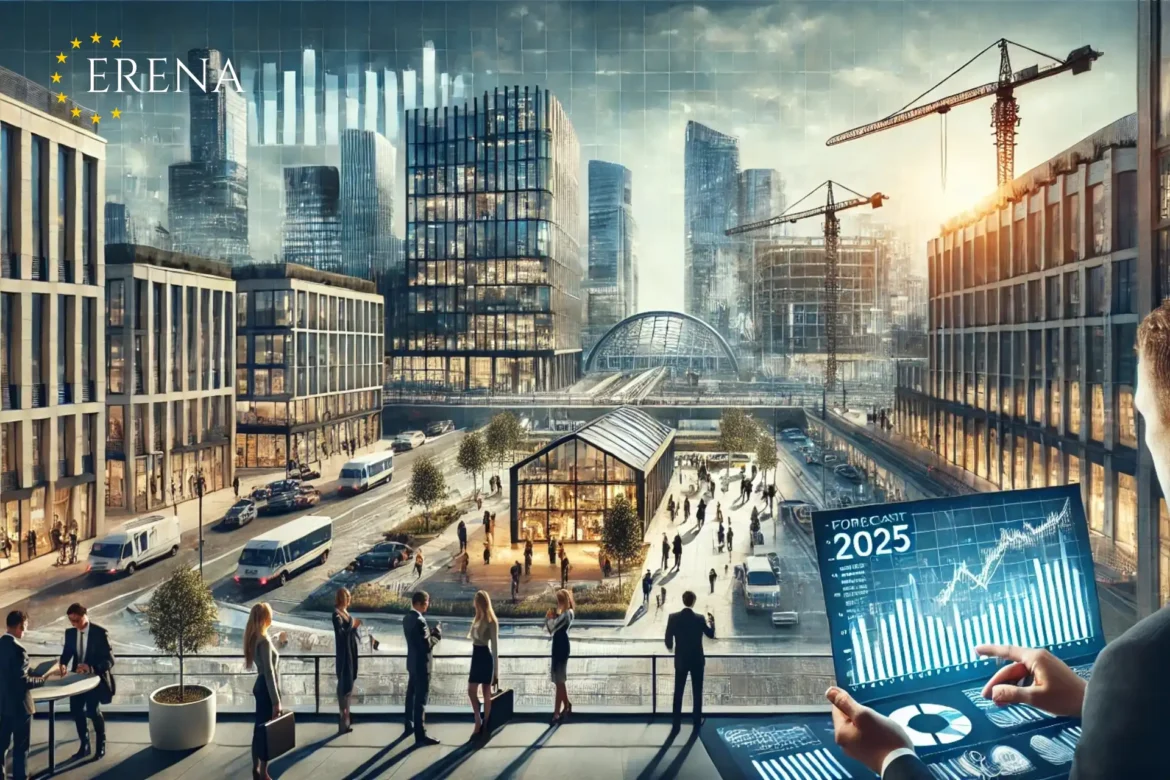The European commercial real estate (CRE) market in 2025 is set to evolve significantly, driven by economic recovery, technological advancements, and shifts in work culture. With inflationary pressures, evolving tenant needs, and the rise of hybrid working, understanding these trends will be crucial for investors, developers, and property managers. Let’s dive into the key developments shaping the CRE landscape in Europe for 2025.
1. Economic Outlook and Macroeconomic Impact
In 2025, the European CRE market will face both challenges and opportunities tied to macroeconomic factors. Economic recovery will continue, but inflation and rising interest rates could impact investment strategies and capital availability.
- Interest Rates and Inflation: Higher interest rates and inflation will increase borrowing costs, affecting both investment and development decisions. This is expected to lead to more cautious investment approaches, with investors focusing on stable income-generating assets.
- Price Trends: Construction and operational costs are projected to remain high, pushing rental prices upwards in the long term. Prime locations will see stable rent, while secondary markets could offer more affordable alternatives.
2. Office Space Demand: Hybrid Work Revolution
Office spaces in Europe will continue to adapt to the ongoing hybrid work model, where flexibility and adaptable environments are in high demand.
- Key Office Markets: Major cities like London, Paris, Berlin, and Amsterdam will remain hubs for office space demand. However, the demand for flexible leases, co-working spaces, and mixed-use developments combining office, retail, and leisure will increase.
- Office Rental Prices: In top markets, prime office rents are expected to stay stable, while secondary cities may offer more affordable options. For example, rents in London’s West End can reach £70 to £130 per square meter annually.
- Sustainability: Green and energy-efficient office spaces will be in demand, with tenants and landlords focusing on sustainability to meet both regulatory requirements and tenant expectations.
3. Retail Real Estate: Embracing E-Commerce and Omnichannel Retail
The retail sector in Europe is seeing a shift due to the dominance of e-commerce. However, physical stores still hold significant value, especially when integrated with e-commerce strategies.
- Prime Retail Locations: High-demand urban areas like Paris, Milan, and Berlin will see stable demand for retail spaces, particularly for experiential retail stores that bridge the gap between physical and online shopping.
- Retail Rental Prices: Premium retail locations will continue to demand higher rents. For example, stores on Paris’s Champs-Élysées or London’s Oxford Street could reach €10,000 per square meter annually, while secondary locations may have rents between €500 and €2,000 per square meter.
4. Industrial and Logistics Real Estate: Growth Continues
The industrial and logistics sectors in Europe are set to thrive in 2025, driven by the ongoing demand for efficient supply chains and last-mile delivery solutions.
- Key Locations: The Netherlands, Germany, and Poland will continue to be prime markets for industrial real estate. Strategic locations near transportation hubs will see high demand for warehouses and distribution centers.
- Industrial Rental Prices: Rental prices in logistics hubs will rise. In cities like Frankfurt or Rotterdam, logistics space rents may reach €5 to €10 per square meter per month. Smaller industrial areas in secondary markets could see lower rents, ranging from €3 to €6 per square meter.
5. Investment Trends: Stability Amid Uncertainty
Despite macroeconomic uncertainties, Europe’s commercial real estate market remains an attractive destination for international investors seeking stable returns.
- Investor Sentiment: Institutional investors, including pension funds and sovereign wealth funds, will continue targeting prime real estate assets, particularly in core markets. However, higher interest rates may lead to a rise in capitalization rates for higher-risk assets.
- Cap Rates and Pricing: Core real estate assets in major cities will maintain stable prices, while non-core markets may see cap rate increases due to higher borrowing costs.
6. Sustainability and Technology Integration in CRE
Sustainability and technology will be essential in shaping the future of European commercial real estate. From energy-efficient buildings to smart technologies, sustainability is becoming a driving factor for both tenants and investors.
- Smart Buildings: The demand for technologically advanced buildings with AI-driven management systems and energy-saving features will grow. These properties are seen as more efficient, providing long-term operational savings.
- Regulatory Pressures: European cities are tightening regulations on carbon emissions, and properties that meet environmental benchmarks will command premium rents, attracting high-quality tenants.
Conclusion
The European commercial real estate market in 2025 will be shaped by a mix of economic pressures, technological advancements, and evolving tenant needs. Key trends include the rise of hybrid office spaces, the ongoing growth of industrial real estate, and the shift towards sustainability. While some sectors may face challenges, the overall market outlook remains positive, with opportunities for investors who focus on flexibility, sustainability, and high-demand locations.
Investors, developers, and property managers must adapt to these changes by staying informed, embracing technology, and prioritizing sustainability to succeed in the European commercial real estate market of 2025.

